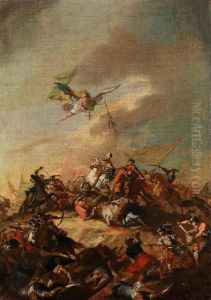Franz Martin Kuen Paintings
Franz Martin Kuen was a notable German artist, born in 1719 in Weißenhorn, then part of the Holy Roman Empire. He was renowned for his work as a painter and engraver, contributing significantly to the artistic movements of his time. Kuen's life and career were deeply embedded in the artistic and cultural milieu of 18th century Europe, a period that was characterized by a rich diversity of artistic expressions and the beginning of the modern aesthetic sensibility.
Kuen received his initial artistic training in the region of his birth, which was a vibrant center for art and culture in southern Germany. He later traveled extensively across Europe, a common practice among artists of his time, which allowed them to study different styles and techniques. This exposure had a profound impact on his artistic development, enabling him to incorporate a variety of influences into his work, ranging from the Baroque to the emerging Rococo style.
Throughout his career, Franz Martin Kuen was celebrated for his mastery in painting and engraving. His works often depicted religious themes, a common subject in the art of the period, yet he also explored secular themes, showcasing his versatility as an artist. Kuen’s paintings are characterized by their detailed and dynamic compositions, vibrant use of color, and the emotional depth of the figures portrayed. His engravings, meanwhile, are noted for their precision and the clarity of line, reflecting his skill in this demanding art form.
Kuen’s contributions to the art world were recognized by his contemporaries, and his works were sought after by the church, nobility, and emerging bourgeoisie, who were the main patrons of art during the 18th century. Despite his success, detailed records of his life and works are relatively sparse, a common issue for many artists of his era, due to the limited documentation practices of the time.
Franz Martin Kuen passed away in 1771, leaving behind a legacy that has been appreciated by generations of art historians and enthusiasts. His works continue to be studied and admired for their beauty and technical skill, offering insights into the artistic trends and cultural contexts of 18th century Europe. Kuen remains a significant figure in the history of German art, representing the richness and diversity of artistic expression during a pivotal period in European art history.
